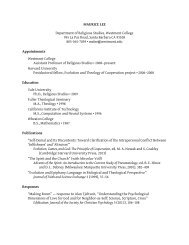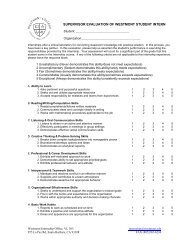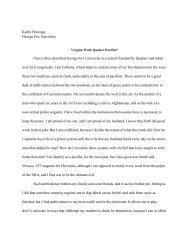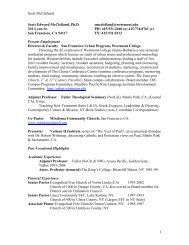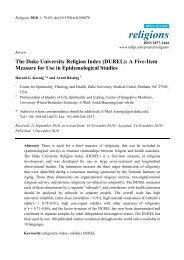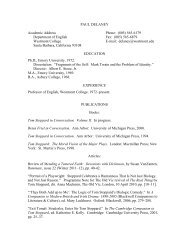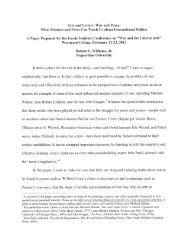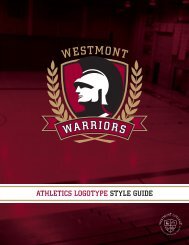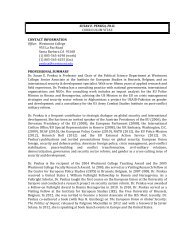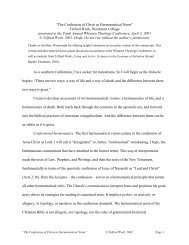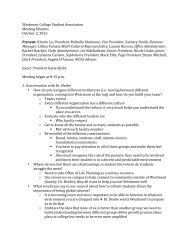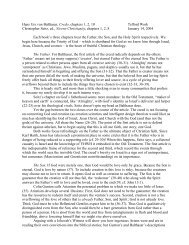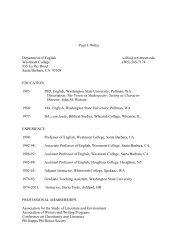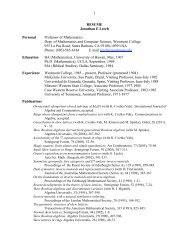Plagiarism Policy (pdf) - Westmont College
Plagiarism Policy (pdf) - Westmont College
Plagiarism Policy (pdf) - Westmont College
Create successful ePaper yourself
Turn your PDF publications into a flip-book with our unique Google optimized e-Paper software.
<strong>Westmont</strong> <strong>College</strong> <strong>Plagiarism</strong> <strong>Policy</strong><br />
<strong>Westmont</strong> <strong>College</strong> is a Community of Christian Scholars<br />
When students join our college community, they are expected, as apprentice scholars, to search for truth with integrity<br />
and accuracy. This quest requires humility about our abilities, respect for the ideas of others, and originality in our<br />
thinking. Since <strong>Westmont</strong> is a Christian community, the integrity of our scholarship is rooted in the integrity of our<br />
faith. We seek to be followers of Christ in the classroom, in the library, and at the privacy of our computers. For both<br />
scholarly and spiritual reasons, then, plagiarism and all other forms of academic dishonesty are not to be pursued in<br />
the <strong>Westmont</strong> community.<br />
Responsibilities of Members of the <strong>Westmont</strong> Community<br />
In a scholarly and Christian community, each of us has a responsibility to encourage others to maintain their<br />
commitment to academic honesty. Faculty have a responsibility to educate students about refraining from academic<br />
dishonesty—in particular, plagiarism. Faculty should teach what plagiarism is, how to avoid it, and what the<br />
consequences of plagiarism are (see For Faculty: Reducing and Detecting <strong>Plagiarism</strong>). In addition, as part of their<br />
evaluation of student assignments, they should check for evidence of plagiarism. If evidence is discovered, faculty<br />
should confront the student, apply the appropriate consequences, and report the incident to the Provost.<br />
Students have a responsibility to understand plagiarism and to learn how to avoid it (see For Students: Strategies for<br />
Avoiding <strong>Plagiarism</strong>). They should refuse to allow fellow students “to borrow" or to use an assignment without<br />
proper citation, encourage fellow students to do their own work, and refrain from completing assignments for their<br />
fellow students. If a student helps another plagiarize in these or other ways, he or she is equally guilty of academic<br />
dishonesty (cf. Saupe, 1998).<br />
Definition of <strong>Plagiarism</strong><br />
To plagiarize is to present someone else's work—his or her words, line of thought, or organizational structure—as our<br />
own. This occurs when sources are not cited properly, or when permission is not obtained from the original author to<br />
use his or her work. By not acknowledging the sources that are used in our work, we are wrongfully taking material<br />
that is not our own. <strong>Plagiarism</strong> is thus an insidious and disruptive form of dishonesty. It violates relationships with<br />
known classmates and professors, and it violates the legal rights of people we may never meet.<br />
Another person's "work" can take many forms: printed or electronic copies of computer programs, musical<br />
compositions, drawings, paintings, oral presentations, papers, essays, articles or chapters, statistical data, tables or<br />
figures, etc. (The Learning Skills Centre, 1999). In short, if any information that can be considered the intellectual<br />
property of another is used without acknowledging the original source properly, this is plagiarism.<br />
Forms of <strong>Plagiarism</strong><br />
Various types and levels of plagiarism are recognized at <strong>Westmont</strong>, and all are unacceptable in submitted<br />
assignments. Unless an instructor specifies otherwise, the following general definitions apply.<br />
Minimal plagiarism is defined as doing any of the following without attribution:<br />
• inserting verbatim phrases of 2-3 distinctive words.<br />
• substituting synonyms into the original sentence rather than rewriting the complete sentence.<br />
• reordering the clauses of a sentence.<br />
• imitating the sentence, paragraph, or organizational structure, or writing style of a source (Saupe, 1998;<br />
Student Judicial Affairs, UCD, 1999).<br />
• using a source's line of logic, thesis or ideas.<br />
Substantial plagiarism is defined as doing any of the following without attribution:<br />
• inserting verbatim sentences or longer passages from a source.<br />
• combining paraphrasing with verbatim sentences to create a paragraph or more of text.<br />
• repeatedly and pervasively engaging in minimal plagiarism.<br />
1
Complete plagiarism is defined as doing any of the following without attribution:<br />
• submitting or presenting someone's complete published or unpublished work (paper, article, or chapter)<br />
(Wilhoit).<br />
• submitting another student's work for an assignment, with or without that person's knowledge or consent<br />
(Wilhoit).<br />
• using information from a campus file of old assignments (Wilhoit).<br />
• downloading a term paper from a web site (Wilhoit).<br />
• buying a term paper from a mail order company or web site (Wilhoit).<br />
• reusing or modifying a previously submitted paper (e.g., from another course) for a present assignment<br />
without obtaining prior approval from the instructors involved.<br />
Consequences of <strong>Plagiarism</strong><br />
<strong>Plagiarism</strong> may occur intentionally or unintentionally, but intent is not a factor in determining whether plagiarism has<br />
occurred or what consequences apply (e.g., Student Judicial Affairs, UCD, 1999). An analogy is the licensed driver<br />
who is responsible for knowing and abiding by the rules of the road. Ignorance does not excuse the driver if a law is<br />
broken. Likewise, a writer is responsible for knowing and using the rules for being accurate and honest in his or her<br />
writing. Pleading ignorance of the rules does not prevent the consequences from being applied.<br />
Assumptions<br />
1. The faculty member has previously made available information about plagiarism, why it is unacceptable, and<br />
how to avoid it through proper handling and acknowledgement of others' ideas.<br />
2. Any offense which results in a failing grade is reported to the Provost's Office.<br />
3. When determining a consequence for plagiarism, previous offenses in other courses and class rank of the<br />
student are relevant.<br />
Minimal <strong>Plagiarism</strong><br />
When instances of minimal plagiarism are detected, the instructor can use these situations as an educational<br />
opportunity to discuss with the student the nature of plagiarism and the values of a scholarly, Christian community.<br />
At the professor's discretion, assignments may be rewritten and resubmitted, with or without a grade penalty.<br />
Repeated instances of minimal plagiarism may, at the professor's discretion, be treated as substantial plagiarism. If<br />
the professor plans to exercise his or her discretion in cases of minimal plagiarism, procedures and consequences<br />
should be clearly described in the course syllabus.<br />
Faculty are encouraged to keep records of all such instances (e.g., in the form of a report to the Provost) to help<br />
complete the picture of a student's academic record.<br />
Substantial <strong>Plagiarism</strong><br />
First offense. Ordinarily, the student receives a failing grade on the assignment that has been plagiarized, and a<br />
Report of <strong>Plagiarism</strong> is submitted to the Provost's Office.<br />
Second offense. Ordinarily, the student receives a failing grade in the course, and a Report of <strong>Plagiarism</strong> is submitted<br />
to the Provost's Office.<br />
Third offense. The student should be recommended for expulsion from the college. Action is taken at the discretion of<br />
the Provost.<br />
Complete <strong>Plagiarism</strong><br />
First offense. The student receives a failing grade in the course, and a report is submitted to the Provost's Office.<br />
Second offense. The student is expelled from the college. Action is taken at the discretion of the Provost.<br />
When a student is completing the first year at <strong>Westmont</strong>, whether entering immediately after high school or as a<br />
transfer student, he or she may be unfamiliar with plagiarism and how to avoid it. Students who are in their first year<br />
may be allowed to rewrite an assignment that is the first instance of substantial plagiarism. The final grade for this<br />
rewritten assignment would be reduced.<br />
The expectation is that sophomores, juniors, and seniors who are continuing at <strong>Westmont</strong> have been educated about<br />
plagiarism in an earlier semester or year, so these students are familiar with the college's policies and procedures<br />
regarding plagiarism.<br />
2
Delay in Detection of <strong>Plagiarism</strong><br />
If instances of plagiarism are discovered after a course or a degree is completed, the level and frequency of plagiarism<br />
will be evaluated by the Provost in consultation with relevant faculty members. Consequences may include changing<br />
the grade awarded in a course or courses, delaying the awarding of the degree, withholding the degree, or rescinding<br />
the degree.<br />
Procedures for Dealing with <strong>Plagiarism</strong><br />
When a faculty member has reason to believe that plagiarism has occurred on an assignment, the following procedures<br />
should be carried out.<br />
1. Gather the evidence that confirms plagiarism (e.g., make copies of assignment; get citations for, or copies of, the<br />
sources that were plagiarized). In cases where plagiarism cannot be firmly established, the professor is<br />
encouraged to meet with the student to obtain sources or to determine the student's familiarity with the paper that<br />
he or she submitted.<br />
2. If possible, meet with the student to discuss the incident. In this meeting, the following should be addressed:<br />
• Describe the evidence that confirms that plagiarism occurred.<br />
• Listen to the student's response.<br />
• Review what plagiarism is, why it is unacceptable in a scholarly community, and how to cite sources<br />
properly.<br />
• Review the college's plagiarism policy and procedures with the student.<br />
3. After meeting with the student, determine the consequences with the assumption that this is a first offense.<br />
Inform the student what the consequences will be if this is a first offense (e.g., send the student a copy of the<br />
report that is submitted to the Provost’s Office), making sure that other students’ rights to privacy are maintained<br />
(e.g., do not name the other students in conversation with the student about whom the report is filed, and block<br />
out the other students’ names in the report).<br />
4. Document the incident.<br />
• Complete the Report of <strong>Plagiarism</strong> form (attached).<br />
• Submit a copy of the Report of <strong>Plagiarism</strong>, the assignment, and the plagiarized sources to the Provost’s<br />
Office.<br />
• Make and keep a copy of the Report of <strong>Plagiarism</strong>, the assignment, and the plagiarized sources for your own<br />
records.<br />
5. If the Provost’s records indicate that this is not the student’s first offense, the faculty member will be contacted<br />
and can determine, in consultation with the Provost, whether other penalties are warranted. Knowledge of a<br />
student’s prior record should be used in determining penalties, but must not enter into the decision about the<br />
presence or nature of plagiarism (steps 1-3).<br />
After receiving a copy of the Report of <strong>Plagiarism</strong>, a student may comment on the report and submit those comments<br />
to the Provost's Office.<br />
A student who believes that he or she has been unfairly accused or treated may appeal to the Provost.<br />
Each semester, the Provost's Office will prepare a summary of total offenses (across all courses and all semesters) for<br />
each student for whom at least one report has been submitted. This will help to determine consequences in situations<br />
where multiple instances of plagiarism have occurred.<br />
3
Sources<br />
Academic dishonesty: What OSU faculty should know (2001, December 7). Corvallis, OR: Oregon State University.<br />
Retrieved May 15, 2002: http://osu.orst.edu/admin/stucon/facacdis.htm<br />
Bates, P., & Fain, M. (1999, March 5). Detecting plagiarized papers (rev. 2002, January 30). Coastal Carolina<br />
University. Retrieved from World Wide Web, May 27, 2002: http://www.coastal.edu/library/plagiarz.htm<br />
Bowden, D. (1996). Stolen voices: <strong>Plagiarism</strong> and authentic voice. Composition Studies/Freshman English News,<br />
24(1-2), 5-18.<br />
Ehrlich, H. (1998, May 20; rev. 2000, March 20). <strong>Plagiarism</strong> and anti-plagiarism. Newark, NJ: Rutgers University.<br />
Retrieved June 4, 2002: http://newark.rutgers.edu/~ehrlich/plagiarism598.html<br />
Harris, R. (2000, October 2). Anti-plagiarism strategies for research papers. Costa Mesa: CA: Vanguard University.<br />
Retrieved October 31, 2000: http://www.sccu.edu/faculty/R_Harris/antiplag.htm<br />
Hinchliffe, L. J. (1999, January 6). Cut-and-paste plagiarism: Preventing, detecting and tracking online plagiarism.<br />
Retrieved October 31, 2000: http://alexia.lis.uiuc.edu/~janicke/plagiary.htm<br />
The Learning Skills Centre. (1999, January 31). <strong>Plagiarism</strong>. Prince George, BC: The University of Northern British<br />
Columbia. Retrieved November 20, 1999: http://quarles.unbc.edu/lsc/rpplagia.html<br />
Leland, B. (2000 February 22). <strong>Plagiarism</strong> and the Web. Macomb, IL: Western Illinois University. Retrieved October<br />
31, 2000: http://www.wiu.edu/users/mfbhl/wiu/plagiarism.htm<br />
Murray, B. (2002, February). Keeping plagiarism at bay in the Internet age. Monitor on Psychology, 22-24.<br />
Oliphant, T. (2002, March 12). Detecting plagiarism. Edmonton, Alberta: University of Alberta. Retrieved May 15,<br />
2002: http://www.library.ualberta.ca/guides/plagiarism/detecting.html<br />
Oliphant, T. (2001a, November, 1). Preventing plagiarism. Edmonton, Alberta: University of Alberta. Retrieved May<br />
15, 2002: http://www.library.ualberta.ca/guides/plagiarism/preventing.html<br />
Oliphant, T. (2001b, November, 1). Why students plagiarize. Edmonton, Alberta: University of Alberta. Retrieved<br />
May 15, 2002: http://www.library.ualberta.ca/guides/plagiarism/students.html<br />
Regent <strong>College</strong> (2001, October 10). Academic policies. Vancouver, BC: Regent <strong>College</strong>. Retrieved May 27, 2002:<br />
http://www.gospelcom.net/regent/regentnew/student_information/acadinfo/academic_policies.html<br />
Roig, M. (1999). When college students' attempts at paraphrasing become instances of potential plagiarism.<br />
Psychological Reports, 84, 973-982.<br />
Ryan, J. J. C. H. (1998, December). Student plagiarism in an online world. Prism online. Washington, D.C.: American<br />
Society for Engineering Education. Retrieved November 21, 1999:<br />
http://www.asee.org/prism/december/html/student_plagiarism_in_an_onlin.htm<br />
Saupe, K. (1998, September 7). <strong>Plagiarism</strong> policy. Grand Rapids, MI: Calvin <strong>College</strong> English Department. Retrieved<br />
November 20, 1999: http://www.calvin.edu/academic/engl/plagiar.htm<br />
Senechal, G. (no date). Dead giveaways. Retrieved May 28, 2002: http://www.plagiarized.com/deadgive.shtml<br />
Standing, L. G., & Gorassini, D. (1986). An evaluation of the Cloze procedure as a test for plagiarism. Teaching of<br />
Psychology, 13(3), 130-132.<br />
Standler, R. B. (2000). <strong>Plagiarism</strong> in colleges in USA. Retrieved May 27, 2002: http://www.rbs2.com/plag.htm<br />
Student Judicial Affairs. (1999 October). Avoiding plagiarism: Mastering the art of scholarship. Davis, CA: UC<br />
Davis. Retrieved October 31, 2000: http://sja.ucdavis.edu/SJA/plagiarism.<strong>pdf</strong><br />
Tamashiro, R. (1998, April 2). Guiding students in web-based research projects. Proceedings of the 9 th International<br />
Conference of the Society for Information Technology and Teacher Education (SITE), March, 1998,<br />
Washington, D.C. Charlottesville, VA: Association for the Advancement of Computing in Education.<br />
Retrieved November 20, 1999: http://www.coe.uh.edu/insite/elec_pub/HTML1998/tp_tama.htm<br />
Van Belle, G. (no date). How cheating helps drive better instruction. Retrieved May 28, 2002:<br />
http://www.plagiarized.com/vanb.shtml<br />
VanderMey, R., Meyer, V., Van Rys, J., Kemper, D., & Sebranek, P. (2004). The college writer: A guide to thinking,<br />
writing, and researching. Boston: Houghton Mifflin.<br />
Wilhoit, S. (1994). Helping students avoid plagiarism. <strong>College</strong> Teaching, 42(4), 161-165. Retrieved from Academic<br />
Search Elite, EBSCOHost, June 4, 2002:<br />
http://ehostvgw11.epnet.com/ehost.aspkey=204.179.122.140_8000_1569460634&site=ehost&return=n<br />
Williams, S. (1996, June 26). Avoiding plagiarism. Clinton, NY: Hamilton <strong>College</strong>. Retrieved November 20, 1999:<br />
http://www.hamilton.edu/academics/resource/wc/Avoiding<strong>Plagiarism</strong>.html<br />
Writing Tutorial Services: Writing Resources. (1998, August 10). <strong>Plagiarism</strong>: What it is and how to recognize and<br />
avoid it. Bloomington, IN: Indiana University. Retrieved November 20, 1999:<br />
http://www.indiana.edu/~wts/wts/plagiarism.html<br />
4



